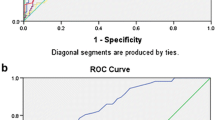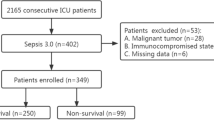Summary
Objective
To investigate the prognostic value of the presepsin:albumin ratio and C‑reactive protein:albumin ratio in patients with sepsis in the intensive care unit (ICU).
Methods
A total of 228 (129 males and 99 females) patients with newly diagnosed sepsis were included in the study. The relationship between the C‑reactive protein:albumin ratio, presepsin:albumin ratio, clinicopathologic parameters, and overall survival were investigated. The associations between C‑reactive protein:albumin ratio and presepsin:albumin ratio were evaluated alongside other inflammation-based prognostic scores such as quick Sepsis Related Organ Failure Assessment (qSOFA).
Results
The presepsin:albumin ratio was significantly higher in non-survivors (p < 0.01). Patients with a high presepsin:albumin ratio had worse overall survival compared with patients with high C‑reactive protein:albumin ratio levels (p < 0.001).
Conclusion
Presepsin and presepsin:albumin ratio are markers of adverse prognosis in patients with sepsis and are superior to C‑reactive protein and C‑reactive protein:albumin ratio for this purpose. Presepsin:albumin ratio may be a novel marker of poor prognosis in patients with sepsis in intensive care units.


Similar content being viewed by others
References
Ali TF, Ali AMA, Elnakeeb MM, Bendary NMH. Presepsin is an early monitoring biomarker for predicting clinical outcome in patients with sepsis. Clin Chim Acta. 2016;460:93–101.
Protti A, Singer M. Bench-to-bedside review: potential strategies to protect or reverse mitochondrial dysfunction in sepsis-induced organ failure. Crit Care. 2006;10:228.
Liu B, Chen YX, Yin Q, Zhao YZ, Li CS. Diagnostic value and prognostic evaluation of presepsin for sepsis in an emergency department. Crit Care. 2013;17:R244.
Riedemann NC, Guo RF, Ward PA. Novel strategies for the treatment of sepsis. Nat Med. 2003;9:517–24.
Groselj-Grenc M, Ihan A, Pavenik-Arnol M, Kopitar AN, Gmeiner-Stopar T, Derganc M. Neutrophil and monocyte CD64 indexes, lipopolysaccharide-binding protein, procalcitonin and C‑reactive protein in sepsis of critically ill neonates and children. Intensive Care Med. 2009;35(11):1950–8.
Herzum I, Renz H. Inflammatory markers in SIRS, sepsis and septic shock. Curr Med Chem. 2008;15(6):581–7.
Reinhart K, Meisner M, Brinkhorst FM. Markers for sepsis diagnosis: what is useful? Crit Care Clin. 2006;22(3):503–19.
Endo S, Aikawa N, Fujishima S, et al. Usefulness of procalcitonin serum level fort he discrimination of severe sepsis: a multicenter prospective study. J Infect Chemother. 2006;14(3):244–9.
Fairclough E, Cairns E, Hamilton J, Kelly C. Evaluation of a modified early warning system for acute medical admission and comparision with C‑reactive protein/albumin ratio as a predictor of patient outcome. Clin Med. 2009;9:30–3.
Bas S, Gauthier BR, Spenato U, Stingelin S, Gabay C. CD 14 is an acute-phase protein. J Immunol. 2004;172(7):4470–9.
Seymour CW, Liu VX, Iwashyna TJ, et al. Assessment of clinical criteria for sepsis: for the third international consensus definitions for sepsis and septic shock (sepsis-3). JAMA. 2016;315:762–74.
Martin GS, Mannino DM, Eaton S, Moss M. The epidemiology of sepsis in the United States from 1979 through 2000. N Engl J Med. 2003;348:1546–54.
Angus DC, Linde-Zwirble WT, Lidicker J, Clermont G, Carcillo J, Pinsky MR. Epidemiology of severe sepsis in the United States analysis of incidence, outcome and associated costs of care. Crit Care Med. 2001;29:1303–10.
Mussap M, Noto A, Fravega M, Fanos V. Soluble CD14 subtype presepsin (sCD14-ST) and lipopolysaccharide binding protein (LBP) in neonatal sepsis: new clinical and analytical perspectives for two old biomarkers. J Matern Fetal Neonatal Med. 2011;24:12–4.
Naitoh K, Shirakawa K, Hirose J, et al. The new sepsis marker sCD14-ST (PRESEPSİN): introduction mechanism in the rabbit sepsis mpdels. Crit Care. 2010;14:P19.
Rivers EP, Ahrens T. Improving outcomes for severe sepsis and septic shock: tools for early identification of at-risk patients and treatment protocol implementation. Crit Care Clin. 2008;24(3):S1–S47.
Endo S, Suzuki Y, Takahashi G, et al. Usefulness of presepsin in the diagnosis of sepsis in a multicenter pospective study. J Infect Chemother. 2012;18(6):891–7.
Glück T, Silver J, Epstein M, Cao P, Farber B, Goyert SM. Parameters influencing membrane CD14 expression and soluble CD14 levels in sepsis. Eur J Med Res. 2001;6(8):351–8.
Al-Shaiba R, McMillan DC, Angerson WJ, Leen E, McArdle CS, Horgan P. The relationship between hypoalbuminaemia, tumour volüme and tje systemic inflammatory response in patients with colorectal liver metastases. Br J Cancer. 2004;91(2):205–7.
Argiles JM, Busquets S, Lopez-Soriano FJ. Cytokines in the pathogenesis of cancer cachexia. Curr Opin Clin Nutr Metab Care. 2003;6(4):401–6.
Forrest LM, McMillan DC, McArdle CS, Angerson WJ, Dunlop DJ. Comparison of an inflammation-based prognostic score (GPS) with performance status (ECOG) in patients receiving platinum-based chemotherapy for inoperable non-small-cell lung cancer. Br J Cancer. 2004;90(9):1704–6.
Kinoshita A, Onoda H, Imai N, et al. The C‑reactive protein/albümin ratio, a novel inflammation-based prognostic score predicts outcomes in patients with hepatocellular carcinoma. Ann Surg Oncol. 2015;22(3):803–10.
Liu X, Sun X, Liu J, et al. Preoperative C‑reactive protein/albümin ratio predicts prognosis of patients after curative resection for gastric cancer. Transl Oncol. 2015;8(4):339–45.
Xu XL, Yu HQ, Hu W, Song Q, Mao WM. A novel inflammation-based prognostic score, the C‑reactive protein/albumin ratio predict the prognosis of patients with operable esophageal squamous cell carcinoma. PLoS ONE. 2015;10(9):e138657.
Wei XL, Wang FH, Zhang DS, et al. A novel inflammation-based prognostic score in esophageal squamous cell carcinoma: the C‑reactive protein/albumin ratio. BMC Cancer. 2015;15:350.
Author information
Authors and Affiliations
Corresponding author
Ethics declarations
Conflict of interest
M. Kaplan, T. Duzenli, A. Tanoglu, B.C. Guney, Y.O. Tastan, and H.S. Bicer declare that they have no competing interests.
Ethical standards
All procedures followed were in accordance with the ethical standards of the responsible committee on human experimentation (institutional and national) and with the Helsinki Declaration of 1975, as revised in 2008. Informed consent was obtained from all patients included in the study.
Additional information
Publisher’s Note
Springer Nature remains neutral with regard to jurisdictional claims in published maps and institutional affiliations.
Rights and permissions
About this article
Cite this article
Kaplan, M., Duzenli, T., Tanoglu, A. et al. Presepsin:albumin ratio and C-reactive protein:albumin ratio as novel sepsis-based prognostic scores. Wien Klin Wochenschr 132, 182–187 (2020). https://doi.org/10.1007/s00508-020-01618-9
Received:
Revised:
Accepted:
Published:
Issue Date:
DOI: https://doi.org/10.1007/s00508-020-01618-9




